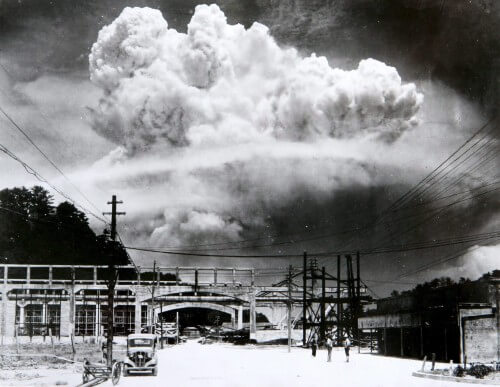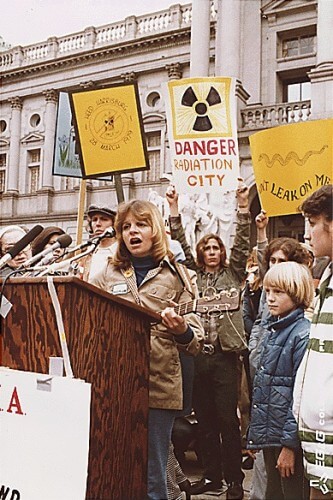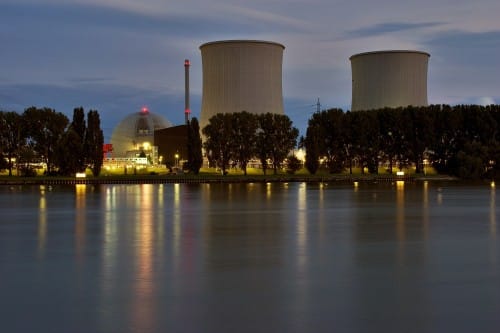On the occasion of the 70th anniversary of the dropping of the nuclear bombs on Japan, four years since the Fukushima disaster and 29 years since the Chernobyl disaster - what are the advantages and disadvantages of nuclear energy and does it have a place in Israel as well
Dr. Daniel Medar, website Angle

This week marks the 70th anniversary of the dropping of the atomic bombs on the Japanese cities of Hiroshima and Nagasaki at the end of World War II. This event marks the official beginning of the Atomic Age. In these bombings the destructive power of atomic fission was demonstrated and in them the initial source of human anxiety about the enormous power of nuclear fission can be found. This anxiety was intensified during the Cold War, when the Western and Eastern blocs were often on the verge of nuclear war - as in the case of the Cuban Missile Crisis, in October 1962.
Along with the terrible danger inherent in atomic power, it also has, of course, a huge potential for energy production. However, as science progressed in exploiting this potential for civilian needs, some of the anxiety about nuclear war also moved to the field of nuclear energy. In the 60s and 70s of the last century, a global protest movement began against the use of nuclear energy, which was seen as dangerous to man and the environment. The opponents of nuclear energy received proof of their righteousness in 1979, when an accident at the Three Mile Island nuclear reactor in Pennsylvania, United States, caused the release of a large amount of radioactive materials into the environment. Following the activity of the global protest movement and coupled with the fact that fossil fuel prices were very cheap at the time, there was a significant slowdown in the development and construction of nuclear reactors in the world. Today, only about 10 percent of the electricity in the world is produced from nuclear energy.
radiation pollution
In a nuclear fission reaction, nuclei of atoms or subnuclear particles collide with each other causing new nuclei or subnuclear particles to be formed. Such a change in the structure of an atomic nucleus causes the release of a large amount of energy. In a nuclear reactor, uranium nuclei undergo nuclear fission in a controlled and slow manner. The energy released is used to heat water into steam, which drives turbines to generate electricity. The uniqueness of such a process is that a very small amount of raw material can produce a huge amount of energy.
During the 64 years that have passed since the construction of the first experimental nuclear reactor that produced electricity, there have been about a hundred accidents in nuclear reactors, of which only three were serious accidents with extensive effects on the environment: the accident at Three Mile Island, the Chernobyl disaster (Ukraine) in 1986, and the Fukushima disaster (Japan) in 2011. There is no doubt that the long-term problem in the event of a nuclear accident is radiation pollution, which can spread over large areas and remain in some places for decades or even thousands of years. However, it should be remembered that the direct deaths from radiation from these three major accidents amounted to less than 50 people, while estimates speak of several thousand indirect deaths - due to cancer or birth defects.

In the Three Mile Island disaster in the USA, for example, no one was killed nor was there an increase in the level of morbidity in the area. In Chernobyl, the situation is definitely more complicated to check, this is because of the vigorous actions carried out by the government in the former Soviet Union to hide the disaster and to eliminate deaths and illnesses that were related to it. However, alongside the Soviet cover-up, there is an argument that in the years following the breakup of the Soviet Union, Ukraine and Belarus, the countries most severely affected by the Chernobyl disaster, amplified the damage of the disaster in order to receive more international aid. There are studies that even claim that the approach in those countries to perpetuate the population exposed to the disaster as victims and not as survivors - caused large sections of the population to suffer anxiety and psychological and psychiatric damage that caused many medical problems, such as exhaustion, weakness of the immune system, addictions, heart disease and more.
In terms of the cost of treating the spill, it is estimated that the cleaning and protection operations in the disaster at Three Mile Island in the USA cost about a billion dollars. The treatment of the Chernobyl disaster cost several hundreds of billions of dollars over 30 years (containment, cleanup, evacuation, resettlement, support for victims, and more). These are considerable amounts, but compared to the costs of fossil fuels in the world they are almost insignificant: fossil fuels cause damage estimated at two trillion dollars and six million deaths every year from air pollution.
Renewable energies vs nuclear energy
Nuclear energy can be compared in terms of greenhouse gas emissions and pollutants (non-radioactive) to wind energy. In fact, it is even better than solar energy in its current form. Most of the environmental impact in nuclear energy is in the mining of the raw materials, the construction of the facilities and the end of the life of the facilities. The energy production itself is cheap and hardly harms the environment. Of course, all these energy sources are better than fossil fuels. Nuclear energy is more problematic than renewable energies mainly in the radioactive pollution created during mining, in the serious pollution that can occur during a malfunction, as well as in the pollution created during the disposal of nuclear waste.
The great advantages of nuclear energy over renewable energies are the ability to provide a lot of electricity through a limited number of installations (tens to thousands of renewable energy installations compared to one nuclear installation); XNUMX times less damage in open areas; and the ability to produce a steady stream of electricity regardless of climate and weather.
In addition, until large-capacity energy storage means come into commercial use, renewable energies cannot be relied upon, power plants operating on fossil fuels must be kept as a backup, and there are high operating costs, which result from the instability of the electricity grid and the need to turn generating units on and off with high frequency.
However, alongside the scientific and statistical considerations, nuclear energy raises concerns and challenges of a different kind. Thus, for example, we have to weigh the desire of the terrorist organizations in the world who would be happy to get their hands on such a deadly means. Such a terrorist organization does not need a nuclear bomb to cause damage on a massive scale - it is enough to detonate an ordinary bomb containing several tens of kilograms of spent nuclear fuel in the center of a large city (or crash a plane into an unprotected nuclear reactor) to cause a god-awful riot. Although, there won't be many deaths, relatively speaking, but there will be huge chaos due to the fear of radioactive radiation. The more nuclear reactors and nuclear fuel there are, the easier it will be to carry out such malicious plans.
Blue-white reactor

Most of the nuclear reactors active in the world today are second generation. In addition, there are about 12 active third generation reactors and others are under construction. Third generation reactors are significantly safer (333-16 times more, depending on the model) than second generation reactors (of the type of reactor in Fukushima) and they are even designed to withstand an airplane collision.
In Israel, the establishment of fourth generation reactors is currently being considered. These are small and modular reactors (SMR - Small Modular Reactor), whose electrical output ranges from 110 to 300 megawatts. If such a reactor explodes, it may cause up to 10 times less damage than the existing reactors. Moreover, these reactors will be even safer than third-generation reactors, and they address several safety problems in reactors built so far: the reactor systems can overcome any malfunction without needing external operator intervention or an additional energy source. In addition, because SMR type reactors are significantly smaller in size than a normal nuclear reactor, the ratio between the surface of the reactor tank and the amount of fission products inside is much greater than in a normal reactor. This figure makes it possible to more easily remove the residual heat from the core and thus reduce the risk of the core melting by passive cooling through natural heat conduction.
To this day, no government decision has been made in Israel regarding the establishment of nuclear power plants (NPPs) in the territory of the State of Israel. In the Ministry of National Infrastructures, Energy and Water, it has been operating for about two years under the Chief Scientist Unit of the Tajar Administration, when it is partially staffed. The administration is mainly concerned with creating the preliminary conditions that will enable the establishment of a nuclear power plant in Israel, if such a decision is made.
The establishment of a blue-and-white nuclear power plant is being examined mainly because, according to estimates, in 2050 the Israeli economy will lack 20 percent of its electricity consumption expectations (despite the abundance of gas in our sea). Also, it is desirable to diversify the country's energy sources and not rely on only one or two sources.
What is the situation in the world today?
Following the Fukushima disaster, many Western countries closed their nuclear programs and other countries reduced them. However, it must be remembered that a country like Germany, for example, that made a decision to close the reactors it owns is in a political, economic and financial situation that is completely different from Israel. Germany is connected to its neighbors by an "electric grid", and has the ability to receive electricity, or to "give" electricity that is in excess. In contrast, Israel is a "nuclear island" and therefore must be able to meet all its energy needs independently.
Japan itself, by the way, decided very recently not to close the reactors in its possession, due to the expectation of a significant shortage of energy sources in the country. Japanese reactors shut down following the Fukushima disaster are today undergoing "re-evaluation" and maintenance processes before reopening. In addition, contrary to the trend in some of the Northwestern European countries, many countries in Eastern Europe, the Middle East and Southeast Asia are planning to build new nuclear plants.
Today there are more and more climate scientists who are calling for the adoption of third and fourth generation nuclear energy as the only current solution to reducing greenhouse gas emissions on a global scale, with minimal damage to open areas. who knows? If the world had not withdrawn from the adoption of nuclear energy in the 70s of the last century and continued to expand the use of nuclear energy in the world, it is possible that today our greenhouse gas emissions would be reduced by half.
An animated video about how a nuclear reactor works

One response
I am puzzled by this review which completely ignores much better and interesting options for nuclear fission that are under development. This is a molten salt reactor, which can operate on thorium, plutonium, depleted uranium and other fissile materials that are relatively abundant. The reactor is energy efficient and much safer to use. Normal reactors work on high steam pressure at relatively low temperatures (of about 200-300 degrees) and a reactor of molten salt works at high temperatures (of about 800 degrees) and low pressures, thus avoiding all the danger of heating and steam bursting, you don't even need to build a seal around the reactor. According to my understanding, the reactor is based on negative re-feeding, in contrast to light water reactors, thus completely preventing failures of the type that caused the explosion of the reactor in Chernobyl. In addition, it creates a very small amount of nuclear waste, which needs storage for several hundred years (as opposed to tens of thousands in existing reactors).
I would like to know why a national level expert on nuclear energy is unaware and does not share this issue with us. Why is the state interested in building a dangerous and polluting reactor when a molten salt reactor existed and worked without any problems for about 5 years in the seventies in the USA (I think in New Mexico).